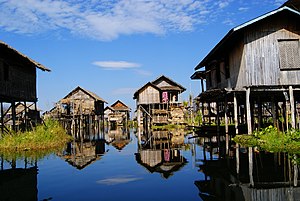Stilt house

Stilt houses (also called pile dwellings or lake dwellings) are houses raised on
Arctic

Houses where permafrost is present, in the Arctic, are built on stilts to keep permafrost under them from melting. Permafrost can be up to 70% water. While frozen, it provides a stable foundation. However, if heat radiating from the bottom of a home melts the permafrost, the home goes out of level and starts sinking into the ground. Other means of keeping the permafrost from melting are available, but raising the home off the ground on stilts is one of the most effective ways.
Indo-Pacific
Raised rectangular houses are one of the cultural hallmarks of the

Building structures on pilings is believed to be derived from the design of raised rice
The majority of Austronesian structures are not permanent. They are made from perishable materials like wood, bamboo, plant fiber, and leaves. Because of this, archaeological records of prehistoric Austronesian structures are usually limited to traces of house posts, with no way of determining the original building plans.
Arbi et al. (2013) have also noted the striking similarities between Austronesian architecture and Japanese traditional raised architecture (
In South Asia, stilt houses are very common in Northeast India, specifically the Brahmaputra Valley regions of Assam, which is extremely prone to regional flooding from the Brahmaputra. These houses are known as chang ghar in Assamese, and as kare okum in Mising; chang ghar are traditionally built by the Mising people, who live along the Brahmaputra. Unlike many forms of traditional architecture, including stilt architecture, in South and Southeast Asia, the construction of chang ghar is making a resurgence and increasing in popularity, as a result of climate change increasing regular flooding in Assam, and the stilts of the chang ghar is adapted to flooding in the first place.[11] The height of the stilts of the chang ghar is determined by the height of the water during the last major flood.[12]
Stilt houses are also popular in Kerala in the Kerala backwaters, another regions with high rainfall and regular flooding from monsoons. Although stilt houses in the Kerala Backwaters have been a traditional method of house construction for many years, following the disastrous 2018 floods in Kerala, many more stilt houses have been constructed recently and utilize concrete as well as timber for their pillars.[13][14]
Stilt houses in China known as guījiǎfángwū (simplified Chinese: 龟甲房屋; traditional Chinese: 龜甲房屋; lit. 'turtle shell house') because Chinese stilt house structures inspired from a turtle and built over water surface (e.g. rivers).
In the late 20th century, stilt houses in extremely calm ocean water became a popular form of tourist lodging known as overwater bungalows; the trend began in French Polynesia and quickly spread to other tourist locations, especially in tropical locales.
Americas
Stilt houses were also built by
Stilt houses are also still common in parts of the
Africa
Stilted granaries are also a common feature in West Africa, e.g., in the Malinke language regions of Mali and Guinea.
Europe

In the
Early
Reconstructed stilt houses are shown in
In the Alps, similar buildings, known as raccards, are still in use as granaries. In England, granaries are placed on staddle stones, similar to stilts, to prevent mice and rats getting to the grain.
In Italy there are several stilt-houses settlements, for example the one on the Rocca di Manerba del Garda.
In Scotland there used to be prehistoric stilt houses called crannogs.[20]
Types
- Diaojiaolou – Stilt houses in southern China.
- Heliotrope – A concept house designed by Rolf Disch with a single stilt, optimized for harnessing solar power.
- Kelong – Built primarily for fishing, but often doubling up as offshore dwellings in the following countries: Philippines, Malaysia, Indonesia and Singapore.
- Bahay Kubo – The traditional house type prevalent in the Philippines.
- Palafito – Found throughout South America since Pre-Columbian times. In the late 19th century, numerous palafitos were built in Chilean cities such as Castro, Chonchi, and other towns in the Chiloé Archipelago, and are now considered a typical element of Chilotan architecture.
- Tankas.
- Motuans, commonly found in the southern coastal area of PNG.
- Queenslander – Stilt house common in Queensland and northern New South Wales, Australia.
- Chaang Ghar – A type of stilt house built in valley.
- freshwater, e.g., a lotuspond.
- Vietnamese stilt house – Similar to the Thai ones, except having a front door with a smaller height for religious reasons.
Tourism
Stilt houses as water villas are common in the Maldives and Assam.
Gallery
-
Lakeside Dwelling (1878 painting by Emmanuel Benner)
-
Māori pataka storehouses
-
Lacustrine Village found in Lake Zurich, Switzerland
-
Rumoh Aceh, Acehnese traditional house
-
Stilt houses in Cempa, located in theRiau Islands, Indonesia
-
Stilt houses along Puget Sound in Fragaria, Washington, United States
-
Bajau stilt houses over the sea in the Philippines
-
An African home reconstructed in Germany
-
A bridge between stilt houses (palafito) in Colombia, in Ciénaga Grande de Santa Marta
-
Stilt houses on Tonlé Sap Lake, Cambodia
-
Vacation resort in the Maldives
-
The Sharp Centre for Design at the Ontario College of Art & Design University (OCAD) in Toronto, Ontario, Canada
See also
- Pfahlbaumuseum Unteruhldingen – an English-language article about the stilt house museum in Unteruhldingen, Germany
- Pit-house
- Post in ground
- Prehistoric pile dwellings around the Alps
- Rumah Melayu
- Stiltsville
- Treehouse
- Venice
- Wood pilings
References
- ISBN 978-0-8223-3289-3. Retrieved 27 March 2011.
- ISBN 978-81-8332-295-9. Retrieved 27 March 2011.
- ^ Cambodian Heritage Camp yearbook. Archived from the original on 2017-11-11. Retrieved 2017-06-16.
- ^ a b c d Sato, Koji (1991). "Menghuni Lumbung: Beberapa Pertimbangan Mengenai Asal-Usul Konstruksi Rumah Panggung di Kepulauan Pasifik". Antropologi Indonesia. 49: 31–47.
- ISBN 978-0-521-65630-6. Retrieved 27 March 2011.
- ^ S2CID 145591097.
- ^ ISBN 9789814762762.
- ISBN 9789715425797.
- .
- ISBN 9789004253858.
- ^ "India's Mising community seeks to expand its indigenous adaptation practices in response to climate change". www.preventionweb.net. 21 September 2021. Retrieved 2022-05-11.
- ^ "India's Mising tribe lives in traditional flood-resilient homes to adapt to climate change". Global Voices. 2022-02-09. Retrieved 2022-05-11.
- ISSN 0971-751X. Retrieved 2022-05-11.
- ^ "'Stilt houses can defy floodwaters' | Kochi News - Times of India". The Times of India. TNN. Aug 14, 2019. Retrieved 2022-05-11.
- ^ "Fortified Home Design Pioneered on the Texas Gulf Coast". Texasgulfcoastonline.com. Archived from the original on 2008-09-07. Retrieved 2012-08-01.
- ISBN 978-1-56308-271-9. Retrieved 27 March 2011.
- ISBN 978-1-59942-983-0. Retrieved 28 March 2011.
- ISBN 978-0-415-31720-7. Retrieved 29 March 2011.
- ^ Herodotus, Histories, 5.16
- ^ "What is a Crannog? – the Scottish Crannog Centre".




















